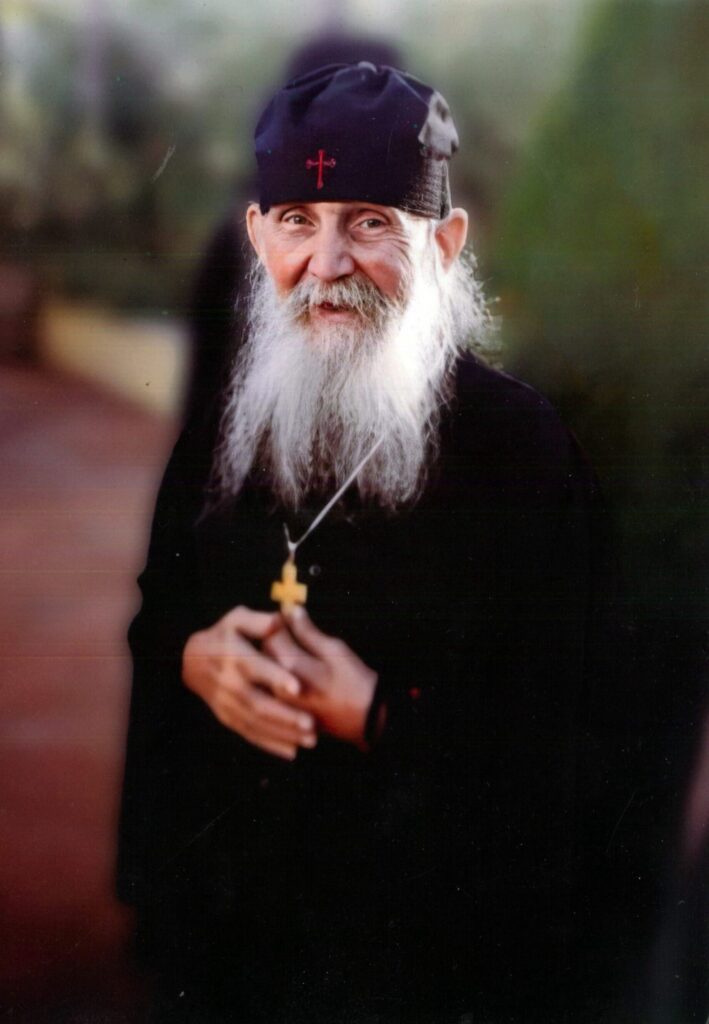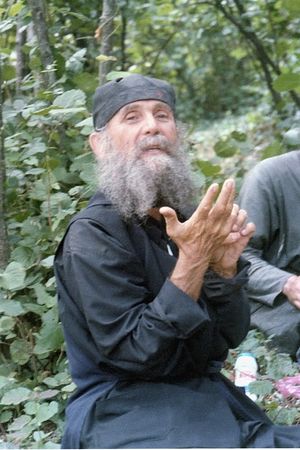
Elder Ephraim of Philotheou and Arizona (1928 – 2019)
Τhe founder of 17 monasteries in America
Ioannis Moraitis (the future Geronda Ephraim) was born in Volos, Greece, to Demetrios and Victoria Moraitis on June 24, 1928, the day the Orthodox Church celebrates the birth of Saint John the Baptist. His mother was a great ascetic, often spending her nights praying with tears and doing countless prostrations, thus setting an example for little Ioannis. One day as she was sitting beside him praying, she had a vision of a star leaving their house and going towards the Holy Mountain. She heard a voice saying, “Of your three children, only this one will live.” At first, she took this literally, thinking her other two children would die. However, she soon understood that this was a prophecy that Ioannis would become a monk on the Holy Mountain. From that point on, she devoted particular attention to his spiritual upbringing, doing everything she could to offer a spotless sacrifice to the Lord.
As Ioannis grew, his desire for monasticism also grew. He started urging his spiritual father to allow him to go to the Holy Mountain, but, his spiritual father, Father Ephraim of Volos, was hoping to start a monastery and wanted to keep Ioannis with him. After some years had passed, Ioannis realized that Father Ephraim was never going to start a monastery, and he decided to go to the Holy Mountain. His mother and Father Ephraim sent him to Saint Joseph the Hesychast, who had also been Father Ephraim’s geronda.

Thus, in the year 1947, Ioannis found himself on the boat for Athos. As he was gazing at the monasteries from the boat, those massive fortresses seemed to him like prisons. His heart became constrained with grief, as if he were facing a life of internment. He asked a monk sitting next to him on the boat where the hut of Geronda Joseph the Hesychast was. The monk saw that Ioannis was all skin and bones, since he was sickly, and told him that he was unfit to join such an austere brotherhood. But when Ioannis insisted, the monk pointed out a small white hut, high up on the mountain like an eagle’s nest. As soon as Ioannis saw how open and free it was, his heart was relieved. It seemed to him like paradise.
When he reached the port of Saint Anne’s Skete, he was met by Father Arsenios, Saint Joseph’s co-ascetic. When Father Arsenios saw him, he asked, “Aren’t you Yiannaki from Volos?” “Yes, Father, but how do you know me?” he replied. “Oh, the Honorable Forerunner appeared to Geronda Joseph last night and said to him, ‘I am bringing you a little lamb. Put it in your sheepfold.’” This was Ioannis’s first encounter with the simple but saintly Father Arsenios, who then led Ioannis up the steep paths to their hut at Little Saint Anne’s Skete.
And so Ioannis began a life of obedience and asceticism next to Saint Joseph. Their life was very austere. They ate only once a day after sundown, did countless prostrations, practiced noetic prayer for hours on end, and kept complete silence, talking only when necessary. And on top of that, Saint Joseph continually reproached and insulted Ioannis.

After nine months, seeing that Ioannis was a model disciple, humble and obedient in everything, Saint Joseph was convinced that he was ready for the monastic tonsure. On July 13, 1948, amid the compunction of their small cave-church, Ioannis was tonsured a great schema monk, receiving the name Ephraim. The saint continued to act harshly towards Father Ephraim, but he did so to uproot the passion of pride from his young disciple’s soul and in fact had boundless love for him. And although the saint was strict, demanding, and often harsh towards his disciples during their daily activities, during their evening confession and revelation of thoughts he was gentle and loving, explaining the reasons for the mistakes they made during the day and teaching them the art of spiritual warfare.
At that time their brotherhood did not have its own priest for their liturgical needs. Saint Ephraim9 of Katounakia10 would come several times a week to perform the liturgy for them. However, Saint Ephraim’s geronda in Katounakia would not always let him go, thus in 1952, Saint Joseph decided to have Father Ephraim ordained a deacon and Father Haralambos a priest. Father Ephraim also cooked for the brotherhood (an obedience he would keep even after his geronda’s death, cooking for his own disciples). They did not have a kitchen, a stove, an oven, or anything of the sort. He had to cook outside over an open fire, sometimes in very harsh weather. Sometimes the wind was so violent that it scattered all his utensils.

Elder Ephraim with his brotherhood, New Skete, Mt. Athos Greece 1960’s
Because of the harsh climate at Little Saint Anne’s, the brotherhood’s health started to deteriorate. Thus in 1953 Saint Joseph decided that they should move. The Holy Monastery of Saint Paul offered them some hesychastic huts by the tower of New Skete. Finding that these huts were just what they were looking for, they decided to move there. At New Skete, they relaxed their ascetical program somewhat in regards to physical labor and diet, but they continued their noetic struggles and long vigils as before. At that time, Father Ephraim was also ordained a priest. At their new hermitage at New Skete they had two chapels: one dedicated to the Holy Forerunner, where Father Haralambos liturgized, and one dedicated to the Annunciation of the Theotokos, where Father Ephraim liturgized.
On August 15, 1959, the day the Orthodox Church celebrates the Dormition of the Theotokos, Saint Joseph reposed in the Lord, leaving his disciples orphaned. Saint Joseph had instructed his disciples to separate after his death and create brotherhoods of their own. Thus, Father Ephraim became the geronda of the hut of the Annunciation of the Theotokos.
It was not long before the virtuous life of Geronda Ephraim started to attract monastic aspirants. Because his brotherhood was growing rapidly, in 1968 they moved to the skete of Provata, to the cell of Saint Artemios. At that time, most of the monasteries on the Holy Mountain were idiorrhythmic, with only a few old monks living in each one. Thus, in 1973, the monks of the Holy Monastery of Philotheou asked the geronda to bring his brotherhood there to help repopulate and re-establish it as a cenobitic15 monastery. Initially, the geronda did not want leave their hesychastic life at Saint Artemios and get involved in the distractions of a monastery. But, after being enlightened by God, he agreed. Thus, on October 1, 1973, Geronda Ephraim was enthroned as abbot of the Holy Monastery of Philotheou, a position he held until 1991.
The brotherhood continued to grow rapidly, reaching eighty monks by 1981. At that time, the monastery of Konstamonitou16 asked Geronda Ephraim to send a group of monks to help them also. He consented and sent a group of twenty monks. The same happened in 1983 and 1986, with two other monasteries, Xeropotamou,17 and Karakalou.18 Thus he revitalized four Athonite monasteries.
In 1979, he went to Canada for medical reasons, and while there, he was invited to confess, counsel, and teach the Orthodox Christians in their churches and homes. Through these meetings he acquired many spiritual children, who urged him to return annually to confess them and guide them in their spiritual lives. He understood that it was God’s will for him to return to Canada and also to visit parishes in the United States. By the appeal of the Orthodox faithful and with the blessing of the bishops of the Greek Orthodox Archdiocese of America, Geronda Ephraim began the work of establishing monastic communities in North America, which he continued to do after his final move to Arizona in 1995. Orthodox faithful throughout the United States and Canada have embraced, supported, and collaborated in this endeavor. These communities provide spiritual guidance, and they help to preserve the holy traditions of the Church through an exemplary Christian life and devotion to God. Also, by handpicking worthy successors (abbots and abbesses), Geronda Ephraim has ensured the continuity of his apostolic work in serving the Church and her needs.
Until 1989, there was only one monastery in the North American Greek Orthodox Archdioceses. Since then, by God’s grace Geronda Ephraim has founded seventeen monasteries in North America, ten for nuns and seven for monks. The Ecumenical Patriarch visited and blessed four of these monasteries, while prayers from all quarters of the Church continue to help support this unparalleled expansion of Orthodox Monasticism in the western hemisphere.

On the night of December 7, 2019, the Forefeast of Saint Anna’s Conception of the Mother of God, Elder Ephraim reposed in the Lord. May his memory be eternal.
All sources are from Saint Anthony’s Greek Orthodox Monastery, Arizona.